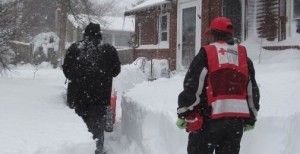 In anticipation of severe winter weather due to impact the East Coast, the American Red Cross has released a Winter Storm Safety Checklist with tips and information about what to do and what supplies are needed in the event of a severe winter storm.
In anticipation of severe winter weather due to impact the East Coast, the American Red Cross has released a Winter Storm Safety Checklist with tips and information about what to do and what supplies are needed in the event of a severe winter storm.
According to the Red Cross, winter storms can range from a moderate snow over a few hours to a blizzard with blinding, wind driven snow that lasts for several days.
Some winter storms are large enough to affect several states, while others affect only a single community. Many winter storms are accompanied by dangerously low temperatures and sometimes by strong winds,
icing, sleet and freezing rain.
With this in mind, it’s important to know the difference between a Winter Storm Outlook, a Winter Weather Advisory, a Winter Storm Watch, and a Winter Storm Warning to know what kind of weather to expect and prepare for.
Winter Storm Outlook – Winter storm conditions are possible in the next 2 to 5 days.
Winter Weather Advisory – Winter weather conditions are expected to cause significant inconveniences and may be hazardous. When caution is used, these situations should not be life threatening.
Winter Storm Watch – Winter storm conditions are possible within the next 36 to 48 hours. People in a watch area should review their winter storm plans and stay informed about weather conditions.
Winter Storm Warning – Life-threatening, severe winter conditions have begun or will begin within 24 hours. People in a warning area should take precautions immediately.
During severe winter weather, dressing appropriately and winterizing vehicles and homes are key.
Dressing in several layers and wearing waterproof, insulated boots to keep feet dry and warm is suggested.
Homes can be easily insulated by installing storm windows or covering windows with plastic from the inside to keep cold air out.
In the event of severe conditions that make travel hazardous, supplies including food, water, medications, and clothing should be kept readily available.
Carbon monoxide poisoning, electric shock, and fire are the primary hazards to avoid when using alternate sources for electricity, heating, or cooking.
To view the complete checklist and for more information on disaster and emergency preparedness, visit www.redcross.org.
If your community experiences a severe winter storm, or any disaster, register on the American Red Cross Safe and well website available through www.redcross.org to let your family and friends know about your welfare.
If you do not have internet access, call 1-866-GET-INFO to register yourself and your family.
Copyright © 2024 EYT Media Group, Inc. All rights reserved. Any copying, redistribution or retransmission of the contents of this service without the express written consent of EYT Media Group, Inc. is expressly prohibited.








